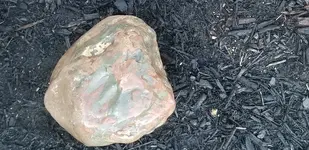You are using an out of date browser. It may not display this or other websites correctly.
You should upgrade or use an alternative browser.
You should upgrade or use an alternative browser.
Strange Rock
- Thread starter nimmers
- Start date
Geochem
Sr. Member
- Joined
- Dec 11, 2016
- Messages
- 274
- Reaction score
- 189
- Golden Thread
- 0
- Primary Interest:
- Metal Detecting
From only the picture I will try.
It appears to be "microcrystalline quartz". It is often a precipitation of silica from groundwater that occurs with limestone lithologies as a sedimentary process (non-metamorphic). They are often formed as "nodules", independent masses like your specimen.
The light blueish-green color sections in your rock are present due to elemental impurities present as the microcrystalline quartz crystals formed.
There also appears to be a shine or luster of the blueish-green color sections. This would indicate water molecules were also integrated in the silica dioxide process, giving the microcrystalline quartz have an opal mineral character. It takes a few percent water in the composition to be classified as an opal.
I would call your rock a high luster opaque to translucent tan to blue-green chert (or flint). Chert and flint are generalistic terms that can mean different rocks in different geographical locations. Microcrystalline quarts is a better term in focusing on origin, composition, and crystalline structure.
With other samples you have on your property, wearing safety glasses, break open one or so with a hammer. You should see "conchoidal fracture planes" - like arrowhead flint rock and glass. A rippled convex curved fracture with fairly sharp to touch edges.
It appears to be "microcrystalline quartz". It is often a precipitation of silica from groundwater that occurs with limestone lithologies as a sedimentary process (non-metamorphic). They are often formed as "nodules", independent masses like your specimen.
The light blueish-green color sections in your rock are present due to elemental impurities present as the microcrystalline quartz crystals formed.
There also appears to be a shine or luster of the blueish-green color sections. This would indicate water molecules were also integrated in the silica dioxide process, giving the microcrystalline quartz have an opal mineral character. It takes a few percent water in the composition to be classified as an opal.
I would call your rock a high luster opaque to translucent tan to blue-green chert (or flint). Chert and flint are generalistic terms that can mean different rocks in different geographical locations. Microcrystalline quarts is a better term in focusing on origin, composition, and crystalline structure.
With other samples you have on your property, wearing safety glasses, break open one or so with a hammer. You should see "conchoidal fracture planes" - like arrowhead flint rock and glass. A rippled convex curved fracture with fairly sharp to touch edges.
Upvote
0
Similar threads
- Replies
- 13
- Views
- 1K
- Replies
- 1
- Views
- 396
Users who are viewing this thread
Total: 1 (members: 0, guests: 1)




